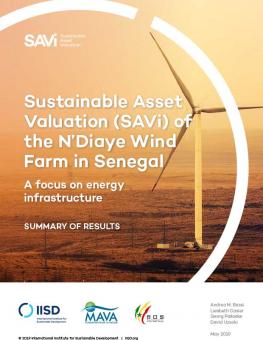
Sustainable Asset Valuation (SAVi) Assessment of the N'Diaye Wind Farm in Senegal
This SAVi analysis on the N'Diaye wind farm project in Senegal demonstrates that, compared to other energy technologies (coal and high-fuel oils), the wind project brings the most benefits to the Senegalese economy and environment.
Key Messages
- The SAVi analysis on the N'Diaye wind farm project in Senegal demonstrates that, compared to other energy technologies (coal and high-fuel oils), the wind project brings the most benefits to the Senegalese economy and environment.
- The analysis shows that the wind project is financially viable, especially when taking into account the externalities and climate-related risks. SAVi also demonstrates the positive impact the project has on employment and a reduction in greenhouse gas emissions.
The Bureau Operationel du Suivi (BOS) of the Plan Emergent Senegal requested that IISD use the SAVi tool to calculate the costs of risks and externalities of the N’Diaye wind farm project. The SAVi analysis demonstrated that the financial attractiveness of sustainable infrastructure projects increases by embedding climate-related risks and externalities.
SAVi simulated financial indicators and externalities such as greenhouse gas emissions, job creation and air pollution for different scenarios and made a comparison with alternative energy technologies (coal and high-fuel oil). Some of the key results of the analysis are the following:
- High-fuel oil-generated electricity is the least attractive option: the levelized cost of electricity, including externalities, is CFA 155,728 per MWh compared to CFA 43,266 per MWh for wind energy and CFA 52,998 per MWh for coal-generated electricity.
- Under a climate risk scenario, embedding a carbon tax and the physical impact of climate change, the internal rate of return from a coal project in comparison with the N'Diaye wind farm decreases from 24 per cent to 13 per cent, while the internal rate of return of the wind project remains steady at 12 per cent.
- Across the life cycle of the project, the wind farm will create, on average, 66 full-time equivalent jobs per year compared to 11 per year on average for a coal-fired power plant with the same capacity.
Funded by
You might also be interested in
Sustainable Asset Valuation (SAVi) of Senegal’s Saloum Delta
The assessment provides an economic valuation of the contribution of the Saloum Delta to local livelihoods and regional development.
A Sustainable Asset Valuation of Non-Motorized Transport in Coimbatore, India
A Sustainable Asset Valuation (SAVi) of the economic, social, and environmental benefits of a non-motorized transport (NMT) network in Coimbatore, India.
Sustainable Asset Valuation of the Kalivaç and Poçem Hydropower Projects
The SAVi results suggest that the hydropower assets cannot be considered a preferable solution to generate electricity for the Albanian people.
An Application of the Sustainable Asset Valuation (SAVi) Methodology: Assessing the economic value of restoring the wetlands of S'Ena Arrubia and Corru S'Ittiri-Marceddì-San Giovanni in the Gulf of Oristano in Sardinia, Italy
This assessment uses the Sustainable Asset Valuation (SAVi) tool to calculate the economic and societal value generated by the S’Ena Arrubia and Corru S’Ittiri-Marceddì-San Giovanni wetlands in the Gulf of Oristano in Sardinia, Italy.